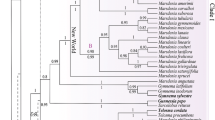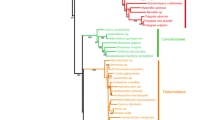Abstract
The taxonomic positions ofRetzia, Desfontainia, andNicodemia have been much discussed, and all three genera have been included inLoganiaceae (Gentianales). We have made a cladistic analysis ofrbcL gene sequences to determine the relationships of these taxa toGentianales. Four newrbcL sequences are presented; i.e., ofRetzia, Desfontainia, Diervilla (Caprifoliaceae), andEuthystachys (Stilbaceae). Our results show thatRetzia, Desfontainia, andNicodemia are not closely related toLoganiaceae or theGentianales. Retzia is most closely related toEuthystachys and is better included inStilbaceae. The positions ofDesfontainia andNicodemia are not settled, butDesfontainia shows affinity for theDipsacales s.l. andNicodemia for theLamiales s.l.
Similar content being viewed by others
References
Airy Shaw, H. K., 1973: J. C. Willis. A dictionary of the flowering plants and ferns. 8th edn. — Cambridge: University Press.
Albert, V. A., Williams, S. E., Chase, M. W., 1992: Carnivorous plants: phylogeny and structural evolution. — Science257: 1491–1495.
Aldrich, J., Cherney, B., Merlin, E., Palmer, J. D., 1986: Sequence of therbcL gene for the large subunit of ribulose bisphosphate carboxylase-oxygenase fromPetunia. — Nucl. Acids Res.14: 9534.
Baillon, H., 1888: Solanacées. Histoire des Plantes4: 281–359. — Paris. Librairie Hachette.
Bartling, F. G., 1830: Ordines naturales plantarum corumque characteres et affinitates. — Göttingen: Dieterich.
Bendre, A. M., 1973: Studies in the familyLoganiaceae. I. Trichomes. — J. Indian Bot.52: 225–234.
Bentham, G., 1857: Notes onLoganiaceae. — J. Proc. Linn. Soc., Bot.1: 52–114.
—, 1876: Genera Plantarum. 2 (2). — London: Lovell, Reeve & Co., Williams & Norgate.
Bremer, B., Struwe, L., 1992: Phylogeny of theRubiaceae and theLoganiaceae: congruence or conflict between morphological and molecular data? — Amer. J. Bot.79: 1171–1184.
Bremer, K., 1988: The limits of amino acid sequence data in angiosperm phylogenetic reconstruction. — Evolution42: 795–803.
Carlquist, S., 1986: Wood anatomy ofStilbaceae andRetziaceae: ecological and systematic implications. — Aliso11: 299–316.
—, 1992: Wood anatomy of sympetalous dicotyledon families: a summary, with comments on systematic relationships and evolution of the woody habit. — Ann. Missouri Bot. Gard.79: 303–332.
Chase, M. W., Soltis, D. E., Olmstead, R. G., Morgan, D., Les, D. H., Mishler, B. D., Duvall, M. R., Price, R. A., Hills, H. G., Qiu, Y.-L., Kron, K. A., Rettig, J. H., Conti, E., Palmer, J. D., Manhart, J. R., Sytsma, K. J., Michaels, H. J., Kress, W. J., Karol, K. G., Clark, W. D., Hedrén, M., Gaut, B. S., Jansen, R. K., Kim, K.-J., Wimpee, C. F., Smith, J. F., Furnier, G. R., Strauss, S. H., Xiang, Q. Y., Plunkett, G. M., Soltis, P. S., Swensen, S., Williams, S. E., Gadek, P. A., Quinn, C. J., Eguiarte, L. E., Goldenberg, E., Learn, G. H. J., Graham, S. W., Barret, S. C. H., Dayanandan, S., Albert, V. A., 1993: DNA sequence phylogenetics of seed plants: an analysis of the plastid generbcL. — Ann. Missouri Bot. Gard.80: 528–586.
Cronquist, A., 1981: An integrated system of classification of flowering plants. — New York: Columbia University Press.
—, 1988: The evolution and classification of flowering plants. 2nd edn. — Bronx, New York: The New York Botanical Garden.
Dahlgren, R., 1983: General aspects of angiosperm evolution and macrosystematics. — Nordic J. Bot.3: 119–149.
—, 1979: Further notes onRetziaceae: its chemical contents and affinities. — Ann. Missouri Bot. Gard.66: 545–556.
Daniel, M., Sabnis, S. D., 1979: Chemotaxonomy ofLoganiaceae. — Curr. Sci.48: 383–385.
Don, D., 1831: On the characters and affinities of certain genera, chiefly belonging to Flora Peruviana. — Edinburgh New Philos. J.1831: 271–280.
—, 1837–1838: A general history of dichlamydeous plants 4. — London: Rivington.
Donoghue, M. J., Olmstead, R. G., Smith, J. F., Palmer, J. D., 1992: Phylogenetic relationships ofDipsacales based onrbcL sequences. — Ann. Missouri Bot. Gard.79: 333–345.
Downie, S. R., Palmer, J. D., 1992: Restriction site mapping of the chloroplast DNA inverted repeat: a molecular phylogeny of theAsteridae. — Ann. Missouri Bot. Gard.79: 266–283.
Doyle, J. J., Doyle, J. L., 1987: A rapid DNA isolation procedure for small quantities of fresh leaf tissue. — Phytochem. Bull.19: 11–15.
Endlicher, S., 1836–1841: Genera plantarum. — Wien: F. Beck.
Engell, K., 1987: Embryology and taxonomical position ofRetzia capensis (Retziaceae). — Nordic J. Bot.7: 117–124.
Gadella, T. W. J., 1980: Cytology. — InLeeuwenberg, A. J. M., (Ed.): Die natürlichen Pflanzenfamilien. Fam.Loganiaceae,28b 1: 202–210. — Berlin: Duncker & Humblot.
Geissman, T. A., Knaack, W. F., Knight, J. O., 1966: Unedoside, a novel iridoid compound. — Tetrahedron Lett.8: 1245–1249.
Gershenzon, J., Mabry, T. J., 1983: Secondary metabolites and the higher classification of angiosperms. — Nordic J. Bot.3: 5–34.
Giseke, 1792:Caroli aLinné. Prielectiones in ordines naturales plantarum. — Paris: B. G. Hoffmann.
Goldblatt, P., Keating, R. C., 1976: Chromosome cytology, pollen structure, and relationship ofRetzia capensis. — Ann. Missouri Bot. Gard.63: 321–325.
Gyllensten, U., 1989: Direct sequencing of in vitro amplified DNA. — InErlich, H. A., (Ed.): PCR technology, 45–49. — New York: Stockton Press.
Hakki, M., 1980: Embryology. — InLeeuwenberg, A. J. M., (Ed.): Die natürlichen Pflanzenfamilien. Fam.Loganiaceae,28b 1: 192–201. — Berlin: Duncker & Humblot.
Hallier, H., 1910: Über Phanerogamen von unsicherer oder unrichtiger Stellung. — Meded. Rijks-Herb.1: 1–40.
—, 1912: L'origine et le système phylétique des angiospermes exposés à l'aide de leur arbre généalogique. — Extrait Arch. Néerlandaises Sci. Exactes Naturelles Série III BI: 146–234.
Hasselberg, G. B. E., 1937: Zur Morphologie des vegetativen Sprosses der Loganiaceen. — Symb. Bot. Upsal.2 (3): 1–170.
Hufford, L., 1992:Rosidae and their relationships to other nonmagnoliid dicotyledons: a phylogenetic analysis using morphological and chemical data. — Ann. Missouri Bot. Gard.79: 218–248.
Humboldt, F. W. A. v., Bonpland, A. J. A., 1808: Plantae aequinoctiales 1. — Paris: F. Schoell.
Hutchinson, J., 1959: The families of flowering plants, dicotyledones 1. 2nd edn. — Oxford: Clarendon Press.
Jensen, S. R., 1992: Systematic implications of the distribution of iridoids and other chemical compounds in theLoganiaceae and other families of theAsteridae. — Ann. Missouri Bot. Gard.79: 284–302.
—, 1975: Iridoid compounds, their occurrence and systematic importance in the angiosperms. — Bot. Not.128: 148–180.
Jussieu, A. L. d., 1789: Genera plantarum. — Paris: Viduam Herissant.
—, 1791: Genera plantarum. — Zürich: Ziegleri & filiorum.
Källersjö, M., Farris, J. S., Kluge, A. G., Bult, C., 1992: Skewness and permutation. — Cladistics8: 275–287.
Kim, K.-J., Jansen, R. K., Wallace, R. S., Michaels, H. J., Palmer, J. D., 1992: Phylogenetic implications ofrbcL sequence variation in theAsteraceae. — Ann. Missouri Bot. Gard.79: 428–445.
Kisakürek, M. V., Hesse, M., 1980: Chemotaxonomic studies of theApocynaceae, Loganiaceae, andRubiaceae with reference to indole alkaloids. — InPhilipson, J. D., Zenk, M. H., (Eds): Indole and biogenetically related alkaloides, pp. 11–29. — London: Academic Press.
Lamarck, J. B. A. P. M. d., 1785: Encyclopédie méthodique. Botanique 1. — Paris: Panchcke.
Leeuwenberg, A. J. M., 1964: TheLoganiaceae of Africa VI.Retzia. — Acta Bot. Neerl.13: 333–339.
—, 1969: Notes on AmericanLoganiaceae IV. Revision ofDesfontainia Ruiz etPav. — Acta Bot. Neerl.18: 669–679.
—, 1979: TheLoganiaceae of Africa XVIIIBuddleja L. II Revision of the African Asiatic species. — Meded. Landbouwhogeschool79: 1–163.
—, 1980: Taxonomy. — InLeeuwenberg, A. J. M., (Ed.): Die natürlichen Pflanzenfamilien. Fam.Loganiaceae,28b 1: 8–96. — Berlin: Duncker & Humblot.
Lin, C. M., Liu, Z. Q., Kung, S. D., 1986:Nicotiana chloroplast genome: X. Correlation between the DNA sequences and the isoelectric focusing patterns of the LS of Rubisco. — Pl. Mol. Biol.6: 81–87.
Lindley, J., 1833: Nixus Plantarum. — London: Ridgway & Filios.
—, 1836: A natural system to Botany. 2nd edn. — London: Longman.
Mabberley, D. J., 1987: The plant book. — Cambridge: Cambridge University Press.
Maldonado de Magnano, S., 1986: Estudios embriologicos enDesfontainia spinosa (Desfontainiaceae). — Darwiniana27: 207–224.
Meisner, C. F., 1836–1843: Plantarum vascularium genera. — Leipzig: Libraria Weidmannia.
Melchior, H., 1964:Buddlejaceae. — InMelchior, H., (Ed.): Engler's Syllabus der Pflanzenfamilien 2, pp. 447–448. — Berlin: Borntraeger.
Mennega, A. M. W., 1980: Anatomy of the secondary xylem. — InLeeuwenberg, A. J. M., (Ed.): Die natürlichen Pflanzenfamilien. Fam.Loganiaceae,28b I: 112–161. — Berlin: Duncker & Humblot.
Metcalfe, C. R., Chalk, L., 1957: Anatomy of the dicotyledons 2. — Oxford: Clarendon Press.
Morgan, D. R., Soltis, D. E., 1993: Phylogenetic relationships among members ofSaxifragaceae sensu lato based onrbcL sequence data. — Ann. Missouri Bot. Gard.80: 631–660.
Olmstead, R. G., Bremer, B., Scott, K. M., Palmer, J. D., 1993: A parsimony analysis of the Asteridae sensu lato based onrbcL sequences. — Ann. Missouri Bot. Gard.80: 700–722.
—, 1992: Monophyly of theAsteridae and identification of their major lineages inferred from DNA sequences ofrbcL. — Ann. Missouri Bot. Gard.79: 249–265.
Persoon, C. H., 1805: Synopsis plantarum 1. — Paris: Cramerun.
Punt, W., 1980: Pollen morphology. — InLeeuwenberg, A. J. M., (Ed.): Die natürlichen Pflanzenfamilien. Fam.Loganiaceae,28b I: 162–191. — Berlin: Duncker & Humblot.
—, 1967: Pollen morphology and taxonomy in theLoganiaceae. — Grana Palynol.7: 469–516.
Rebelo, A. G., 1987: A preliminary synthesis of pollination biology in the Cape flora. — South African National Scientific Programms.
Rimpler, H., 1972: Iridoids fromStilbe species. — Phytochemistry11: 3096–3097.
Saghai-Maroof, M. A., Soliman, K. M., Jorgensen, R. A., Wallard, R. W., 1984: Ribosomal DNA spacer-length polymorphisms in barley: Mendelian inheritance, chromosomal location, and population dynamics. — Proc. Natl. Acad. Sci. USA81: 1769–1778.
Sanger, F., Nicklen, S., Coulson, A. R., 1977: DNA sequencing with chain-terminating inhibitors. — Proc. Natl. Acad. Sci. USA74: 5463–5467.
Schultes, R. E., 1977: De plantes toxicariis e mundo novo tropicale commentationes: 15.Desfontainia: a new Andean hallucinogen. — Bot. Mus. Leafl.25: 99–104.
—, 1989: De speciebus varietatibusqueDesfontainia Columbianae notae. — Revista Acad. Colomb. Ci. Exact.17: 313–319.
Solereder, H., 1892–1895:Loganiaceae. — InEngler, A., Prantl, K., (Eds): Die natürlichen Pflanzenfamilien,4 (2): 19–50. — Leipzig: Engelmann.
Stern, W. L., Brizicky, G. K., Eyde, R. H., 1969: Comparative anatomy and relationships ofColumelliaceae. — J. Arnold Arbor.50: 36–75.
Swofford, D. L., 1991: PAUP: Phylogenetic Analysis Using Parsimony. Computer program. Version 3.1. — Champaign, Illinois: Illinois Natural History Survey.
Takhtajan, A., 1969: Flowering plants. — Origin and dispersal. — Edinburg: Oliver & Boyd.
—, 1987: Systema Magnoliophytorum. — Leningrad: Nauka.
Thonner, F., 1908: Die Blütenpflanzen Afrikas. — Berlin: Friedländer & Sohn.
Thorne, R. F., 1976: A phylogenetic classification of theAngiospermae. — Evol. Biol.9: 35–106.
—, 1983: Proposed new realignments in the angiosperms. — Nordic J. Bot.3: 85–117.
—, 1992: An updated phylogenetic classification of the flowering plants. — Aliso13: 365–389.
Thunberg, C. P., 1776:Retzia capensis, et nytt ört-slag, funnit och beskrivit afC. P. Thunberg. — Physiogr. Sälsk. Handl.1: 55–56.
Wagenitz, G., 1959: Die systematische Stellung derRubiaceae. Ein Beitrag zum System der Sympetalen. — Bot. Jahrb. Syst.79: 17–35.
—, 1964:Gentianales. — InMelchior, H., (Ed.): Engler's Syllabus der Pflanzenfamilien,2: 405–424. — Berlin: Borntraeger.
Wilhelm, K., 1910: Die Samenpflanzen. — Wien, Leipzig: Deuticke.
Xiang, Q., Soltis, D. E., Morgan, D. R., Soltis, P. S., 1993: Phylogenetic relationships ofCornus L. sensu lato and putative relatives inferred fromrbcL sequence data. — Ann. Missouri Bot. Gard.80: 723–734.
Author information
Authors and Affiliations
Rights and permissions
About this article
Cite this article
Bremer, B., Olmstead, R.G., Struwe, L. et al. rbcL sequences support exclusion ofRetzia, Desfontainia, andNicodemia from theGentianales . Pl Syst Evol 190, 213–230 (1994). https://doi.org/10.1007/BF00986194
Received:
Revised:
Accepted:
Issue Date:
DOI: https://doi.org/10.1007/BF00986194




